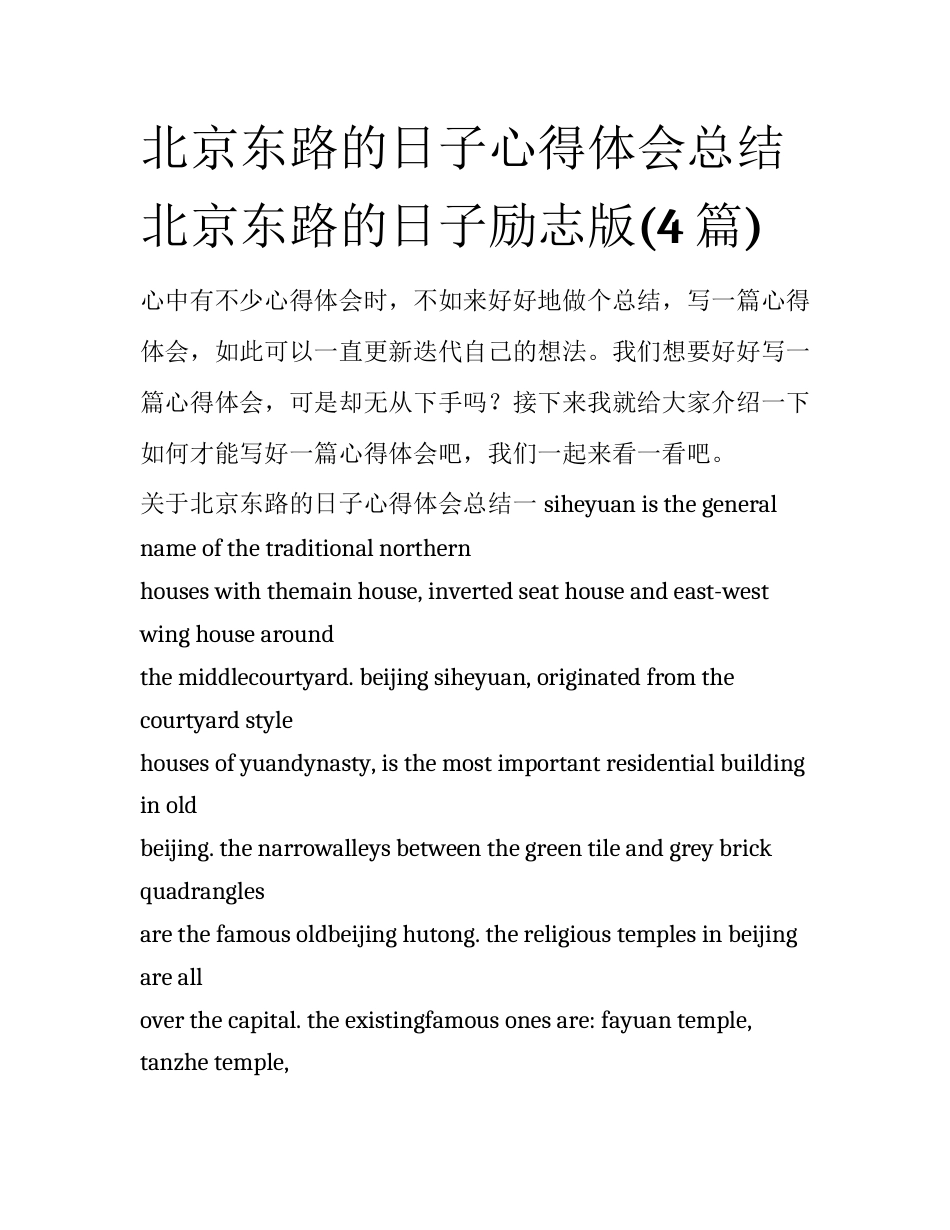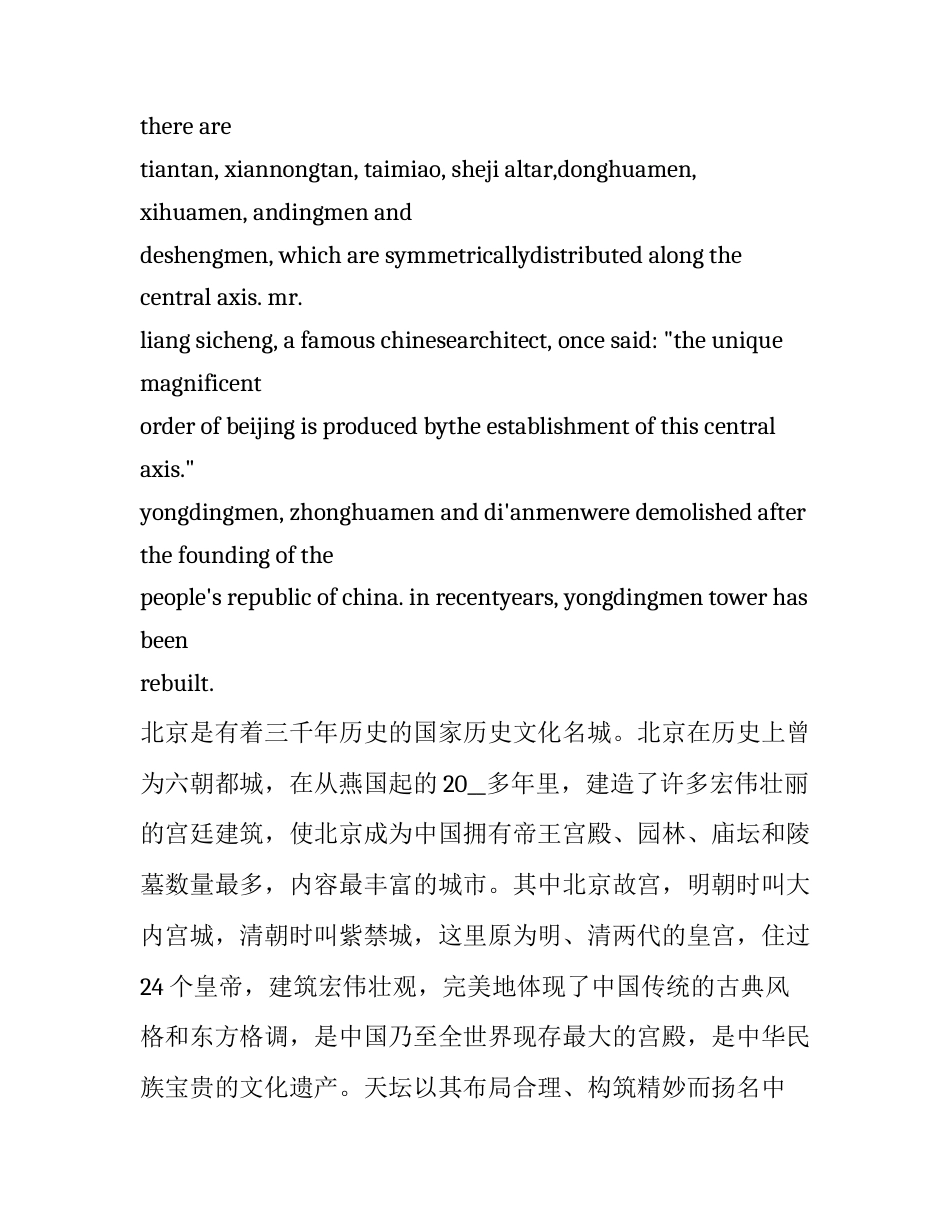北京东路的日子心得体会总结北京东路的日子励志版(4 篇)心中有不少心得体会时,不如来好好地做个总结,写一篇心得体会,如此可以一直更新迭代自己的想法。我们想要好好写一篇心得体会,可是却无从下手吗?接下来我就给大家介绍一下如何才能写好一篇心得体会吧,我们一起来看一看吧。 关于北京东路的日子心得体会总结一 siheyuan is the general name of the traditional northernhouses with themain house, inverted seat house and east-west wing house aroundthe middlecourtyard. beijing siheyuan, originated from the courtyard stylehouses of yuandynasty, is the most important residential buildingin oldbeijing. the narrowalleys between the green tile and grey brick quadranglesare the famous oldbeijing hutong. the religious temples in beijing are allover the capital. the existingfamous ones are: fayuan temple, tanzhe temple,jietai temple, yunju temple,badachu temple, etc. the white cloud view oftaoism. beijing niujie worshiptemple of islam, etc. tibetan buddhism(lamaism), such as the yonghe temple, thecatholic xishiku catholic church,wangfujing catholic church, etc. there aremany christian churches, such asgangwa city church and chongwenmen church. the central axis of beijing refersto the central axis of beijing in yuan,ming and qing dynasties. the urbanplanning of beijing has the characteristicsof symmetry with the palace city asthe center. the central axis of beijingstarts from yongdingmen in the southand ends at zhonggulou in the north, about7.8 km long. from south to north areyongdingmen, qianmen jianlou, zhengyangmen,zhonghuamen, tiananmen, duanmen,wumen, forbidden city, shenwumen, jingshan,di'anmen, houmenqiao, gulou andbell tower. from yongdingmen, the south end ofthe central axis, there aretiantan, xiannongtan, taimiao, sheji altar,donghuamen, xihuamen, andingmen anddeshengmen, which are symmetricallydistributed along the central axis. mr.liang sicheng, a famous chinesearchitect, once said: "the unique magnificentorder of beijing is produced bythe establishment of this central axis."yongdingmen, zhonghuamen and di'anmenwere demolished afterthe founding of thepeople's republic of china. in recentyears, yongdingmen tower hasbeenrebuilt.北京是有着三千年历史的国家历史文化名城。北京在历史上曾为六朝都城,在从燕国起的 20__多年里,建造了许多宏伟壮丽的宫廷建筑,使北京成为中国拥有帝王宫殿、园林、庙坛和陵墓数量最多,内容最丰富的城市。其中北京故宫,明朝时叫大内宫城,清朝时叫紫禁城,这里原为明、清两代的皇宫,住过24 个皇帝,建筑宏伟壮观,完美地体现了中国传统的古典风格和东方格调,是中国乃至全世界现存最大的宫殿,是中华民族宝贵的文化遗产。天坛以其布局合理、构筑精妙而扬名中“”外,是明、清两代皇帝 祭天四合院是以正房、倒座房、东西厢房围绕中间庭院形成平面布局的北方传统住宅的统称。北京四合院源于元代院落式民居,是老北京城最主要的民居建筑。一座座青瓦灰砖的四合院之间形成的窄巷,就是著名的老北京胡同。北京的宗教寺庙遍布京城,现存著名的有:佛教的法源寺、潭柘寺、戒台寺、云居寺、八大处等。道教的白云观等。伊斯兰教的北京牛街礼拜寺等。藏传佛教(喇嘛教)的雍和宫等,天主教西什库天主堂、王府井天主堂等。基督_的缸瓦市教堂、崇文门教堂等。北京中轴线是指元、明、清时的北京城的中轴线,北京的城市规划具有...

